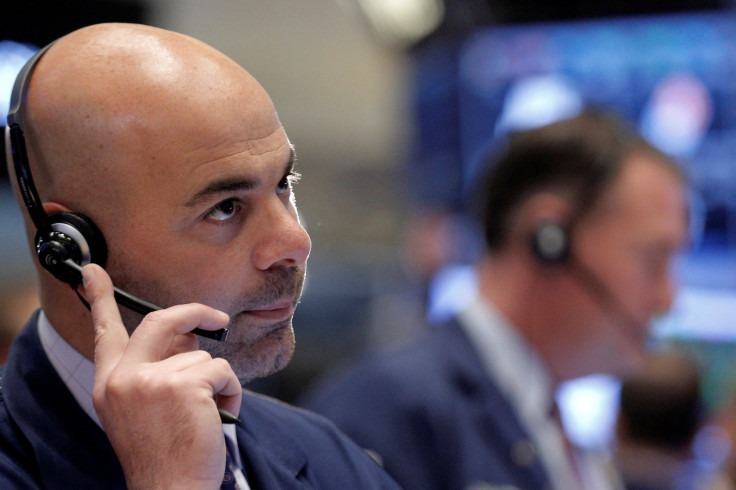Monday's Stock Market Open: US Equities Plunge Despite Global Central Bank Actions, Oil Drops Below $30

KEY POINTS
- Asian markets plunged overnight
- Crude oil futures dropped below $30 per barrel.
- Goldman Sachs expects US GDP to shrink 5% in 2Q
Update: 12:00 p.m. EDT:
U.S. stocks somewhat recovered from earlier massive declines, but still deeply in the loss column.
The Dow Jones Industrial Average dropped 1,710.83 points to 21,474.79 while the S&P 500 fell 178.80 points to 2,532.22 and the Nasdaq Composite Index tumbled 519.04 points to 7,355.84.
In Europe markets dropped but rebounded from early losses as Britain’s FTSE-100 fell 4.73%, France’s CAC-40 plunged 5.48% and Germany’s DAX dropped 4.71%.
Crude oil futures remained under $30 per barrel.
“Markets are still in turmoil, despite another emergency action from the Federal Reserve,” said Greg McBride, chief financial analyst for Bankrate.com. “The Fed’s work is not done as further efforts to backstop credit markets will remain necessary, beyond their current initiatives to buy Treasuries and mortgage-backed securities.”
Update: 11:00 a.m. EDT:
U.S. stocks rebounded from earlier massive declines, but still deeply in the red.
The Dow Jones Industrial Average dropped 1,868.31 points to 21,317.31 while the S&P 500 fell 202.24 points to 2,508.78 and the Nasdaq Composite Index tumbled 586.36 points to 7,288.51.
At one point in early trading, Canadian stocks plunge by a record 13%. The Toronto Stock Exchange was down 7.7% as of 11 a.m
Update: 9:50 a.m. EDT:
After stocks resumed trading following a halt, equities continued to incur even deeper losses.
The Dow Jones Industrial Average dropped 2,768.24 points to 20,417.38 while the S&P 500 fell 291.58 points to 2,419.44 and the Nasdaq Composite Index tumbled 905.23 points to 6,969.64.
Update: 9:40 a.m. EDT:
The S&P 500 index declined by 7%, triggering a "Level 1 Market Wide Circuit Breaker" trading halt for 15 minutes.
Original story:
U.S. stocks plunged on Monday despite a globally coordinated effort by major central banks to provide more liquidity and relax monetary policies.
The Dow Jones Industrial Average dropped 2,250.46 points to 20,935.16 while the S&P 500 fell 220.55 points to 2,490.47 and the Nasdaq Composite Index tumbled 482.15 points to 7,392.73.
A few days after injecting more than $1 trillion in stimulus, on Sunday the Federal Reserve essentially cut interest rates down to zero (a range from zero to 0.25%), the lowest level since 2015. The central bank also introduced a huge $700 billion quantitative easing program. The Fed also cut the rate of emergency lending at the discount window for banks by 125 basis points to 0.25% and increased the term of loans to 90 days.
“The coronavirus outbreak has harmed communities and disrupted economic activity in many countries, including the United States,” the Fed stated.
The Fed joined Bank of Canada, Bank of England, Bank of Japan, European Central Bank, and the Swiss National Bank in a globally coordinate effort to ease monetary conditions and increase liquidity.
“We will maintain the rate at this level until we’re confident that the economy has weathered recent events and is on track to achieve our maximum employment and price stability goals,” Fed Chairman Jerome Powell said. “That’s the test ... some things have to happen before we consider ... we’re going to be watching, and willing to be patient, certainly.”
But analysts warned that coronavirus cases have to peak before fiscal measures can become effective. As of Sunday, the U.S. reported 3,774 confirmed cases and 69 deaths. More than 169,000 cases have been confirmed around the world.
“The Fed blasted its monetary bazooka for sure,” said Peter Boockvar, chief investment officer at Bleakley Advisory Group. “This better work because I don’t know what they have left and no amount of money raining from the sky will cure this virus. Only time and medicine will.”
“This [new action by the Fed], coupled with an important fiscal package, should help cushion the economic downside from the virus’ effect on economic activity,” said Quincy Krosby, chief market strategist at Prudential Financial. “It’s going to be positive, but the market is at the mercy of the virus and at the mercy of whether the containment policies work.”
“In normal circumstances, a large policy response like this would put a floor under risk assets and support a recovery,” said Jason Daw, a strategist at Societe Generale SA in Singapore. “However, the size of the growth shock is becoming exponential and markets are rightfully questioning what else monetary policy can do and discounting its effectiveness in mitigating coronavirus-induced downside risks.”
On Sunday, Jan Hatzius, Goldman Sachs’ chief economist, reduced his first-quarter gross domestic product growth forecast to zero from 0.7%. He also predicted a 5% contraction in the second quarter, followed by a rebound in the second of the year.
“We expect U.S. economic activity to contract sharply in the remainder of March and throughout April as virus fears lead consumers and businesses to continue to cut back on spending such as travel, entertainment, and restaurant meals,” Hatzius said. “Even with monetary and fiscal policy turning sharply further toward stimulus … these shutdowns and rising public anxiety about the virus are likely to lead to a sharp deterioration in economic activity in the rest of March and throughout April.”
In U.S. economic data, the New York Fed said its Empire State Manufacturing Index plunged in March to negative-21.5 -- the lowest since March 2009.
Overnight in Asia, markets closed lower. China’s Shanghai Composite tumbled 3.4%, while Hong Kong’s Hang Seng fell 4.03%, and Japan’s Nikkei-225 dropped 2.46%.
In Europe markets suffered huge losses as Britain’s FTSE-100 fell 7.66%, France’s CAC-40 plunged 10.8% and Germany’s DAX dropped 9.43%.
Crude oil futures plunged 8.67% at $28.98 per barrel, Brent crude dropped 11.08% at $30.10. Gold futures dropped 3.64%.
The euro gained 0.21% at $1.1126 while the pound sterling fell 0.37% at $1.2239.
© Copyright IBTimes 2025. All rights reserved.





















